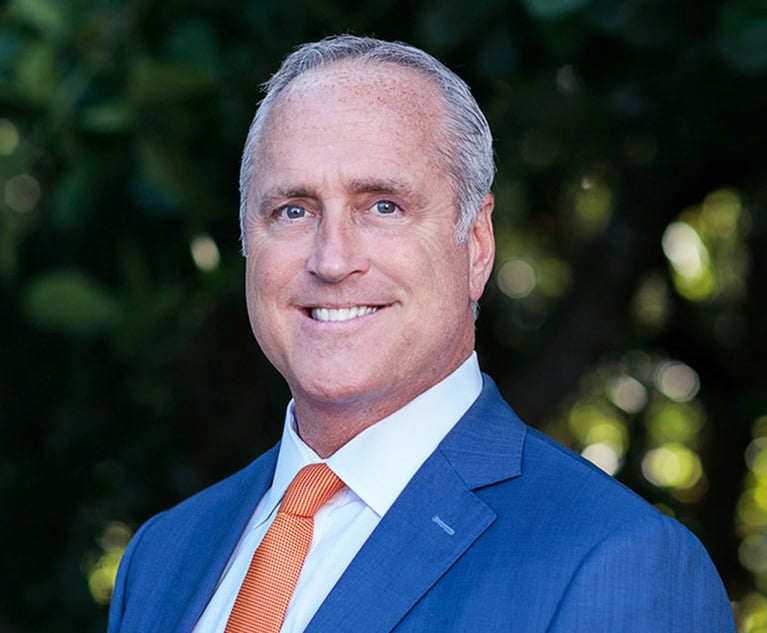Previously Out-of-Fashion Unpaid Internships Given a Makeover by the DOL
In the wake of several lawsuits filed by interns for unpaid wages against fashion powerhouses like Donna Karan, Marc Jacobs, Gucci, The Row, and Hearst Communications (Elle, Marie Claire, Cosmo, Seventeen), the U.S. Department of Labor (DOL) announced that it will use a new test.
October 25, 2018 at 09:08 AM
5 minute read
 Danielle N. Garno, (left) and Elisa M. Hevia, (right) of Greenberg Traurig.
Danielle N. Garno, (left) and Elisa M. Hevia, (right) of Greenberg Traurig.
In the wake of several lawsuits filed by interns for unpaid wages against fashion powerhouses like Donna Karan, Marc Jacobs, Gucci, The Row, and Hearst Communications (Elle, Marie Claire, Cosmo, Seventeen), the U.S. Department of Labor (DOL) announced that it will use a new test—the “primary beneficiary” test—this test was established by the Second Circuit in Glatt v. Fox Searchlight Pictures, 811 F. 3d 528 (2d Cir. 2016)—to determine whether interns are employees (and therefore entitled to minimum wage) under the Fair Labor Standards Act (FLSA).This is a significant policy shift from the DOL's previous test which was found by courts to be too stringent and which just may breathe life back into the fashion industry's internship programs. Under this more flexible test, courts are taking a more holistic approach to determine whether an intern should be paid. You can expect this to affect the way employers market and implement their internship programs.
Primary Beneficiary Test
The concept of the “primary beneficiary” test is quite simple: if the employer primarily benefits from the intern's work, the arrangement is viewed as an employment relationship and the intern is entitled to compensation, (i.e., minimum wage and overtime pay); if the intern primarily benefits from his internship, then an unpaid arrangement is acceptable.
However, as most things in law, nothing is really simple and thus, the application of the test is more complex. The DOL has outlined seven factors to help determine which party is the primary beneficiary of the relationship. The test is flexible, therefore no single factor is determinative and the seven factors are nonexhaustive. So, whether an intern is an employee under the FLSA depends on the unique circumstances of each case. The seven factors are as follows:
- The extent to which the intern and the employer clearly understand that there is no expectation of compensation. Any promise of compensation, express or implied, suggests that the intern is an employee—and vice versa.
- The extent to which the internship provides training that would be similar to that which would be given in an educational environment, including the clinical and other hands-on training provided by educational institutions.
- The extent to which the internship is tied to the intern's formal education program by integrated coursework or the receipt of academic credit.
- The extent to which the internship accommodates the intern's academic commitments by corresponding to the academic calendar.
- The extent to which the internship's duration is limited to the period in which the internship provides the intern with beneficial learning.
- The extent to which the intern's work complements, rather than displaces, the work of paid employees while providing significant educational benefits to the intern.
- The extent to which the intern and the employer understand that the internship is conducted without entitlement to a paid job at the conclusion of the internship.
See https://www.dol.gov/whd/regs/compliance/whdfs71.htm.
Evaluating an Internship Program
The effect of “primary beneficiary” test is to examine the economic reality of internships: Is the intern gaining an educational experience or is the employer benefiting from free labor? This question can be answered by taking three things into consideration: First, what is the intern receiving in exchange for their work? Consider the learning experiences that the intern will take away when the internship ends. Did the intern receive one-on-one training, shadowing opportunities, the opportunity to attend workshops, etc.? Second, what is the economic reality of the internship relationship? Is the employer benefiting from someone who does errands, answers phones, and goes on coffee runs for free? Finally, what is the intern expecting to get out of their internship? Courts are now acknowledging that the intern-employer relationship should not be analyzed in the same manner as the standard employer-employee relationship. Interns usually have the expectation of receiving educational or vocational benefits that are not necessarily expected in other forms of employment—think classroom learning mixed with practical skills development, in a real-world setting.
Implications for the Fashion Industry
This is clearly good news for fashion companies—especially startups and smaller brands—who want to establish or continue unpaid internship programs. However, they should evaluate their programs and structure them accordingly to make sure they comply with the law. Since this is not a one-size-fits-all approach, each company needs to ensure that its program is specifically tailored to the realities of the internship, with an emphasis on educational development. And obviously, a consultation with an employment lawyer is highly recommended.
Danielle N. Garno, of Greenberg Traurig, focuses her practice on issues faced by the fashion community, including, start-up phase and commercial advice, intellectual property such as trademark and copyright infringement, social media marketing, advertising, anti-counterfeiting, as well as employment and general business litigation.
Elisa M. Hevia is an associate in the firm's Miami litigation practice. She concentrates her practice on complex commercial litigation matters in both federal and state courts, representing clients in matters involving breach of contract, fraud and business tort claims. She is also involved in pro bono immigration matters.
This content has been archived. It is available through our partners, LexisNexis® and Bloomberg Law.
To view this content, please continue to their sites.
Not a Lexis Subscriber?
Subscribe Now
Not a Bloomberg Law Subscriber?
Subscribe Now
NOT FOR REPRINT
© 2025 ALM Global, LLC, All Rights Reserved. Request academic re-use from www.copyright.com. All other uses, submit a request to [email protected]. For more information visit Asset & Logo Licensing.
You Might Like
View All

Don’t Forget the Owner’s Manual: A Guide to Proving Liability Through Manufacturers’ Warnings and Instructions
5 minute read

Trending Stories
- 1New York-Based Skadden Team Joins White & Case Group in Mexico City for Citigroup Demerger
- 2No Two Wildfires Alike: Lawyers Take Different Legal Strategies in California
- 3Poop-Themed Dog Toy OK as Parody, but Still Tarnished Jack Daniel’s Brand, Court Says
- 4Meet the New President of NY's Association of Trial Court Jurists
- 5Lawyers' Phones Are Ringing: What Should Employers Do If ICE Raids Their Business?
Who Got The Work
J. Brugh Lower of Gibbons has entered an appearance for industrial equipment supplier Devco Corporation in a pending trademark infringement lawsuit. The suit, accusing the defendant of selling knock-off Graco products, was filed Dec. 18 in New Jersey District Court by Rivkin Radler on behalf of Graco Inc. and Graco Minnesota. The case, assigned to U.S. District Judge Zahid N. Quraishi, is 3:24-cv-11294, Graco Inc. et al v. Devco Corporation.
Who Got The Work
Rebecca Maller-Stein and Kent A. Yalowitz of Arnold & Porter Kaye Scholer have entered their appearances for Hanaco Venture Capital and its executives, Lior Prosor and David Frankel, in a pending securities lawsuit. The action, filed on Dec. 24 in New York Southern District Court by Zell, Aron & Co. on behalf of Goldeneye Advisors, accuses the defendants of negligently and fraudulently managing the plaintiff's $1 million investment. The case, assigned to U.S. District Judge Vernon S. Broderick, is 1:24-cv-09918, Goldeneye Advisors, LLC v. Hanaco Venture Capital, Ltd. et al.
Who Got The Work
Attorneys from A&O Shearman has stepped in as defense counsel for Toronto-Dominion Bank and other defendants in a pending securities class action. The suit, filed Dec. 11 in New York Southern District Court by Bleichmar Fonti & Auld, accuses the defendants of concealing the bank's 'pervasive' deficiencies in regards to its compliance with the Bank Secrecy Act and the quality of its anti-money laundering controls. The case, assigned to U.S. District Judge Arun Subramanian, is 1:24-cv-09445, Gonzalez v. The Toronto-Dominion Bank et al.
Who Got The Work
Crown Castle International, a Pennsylvania company providing shared communications infrastructure, has turned to Luke D. Wolf of Gordon Rees Scully Mansukhani to fend off a pending breach-of-contract lawsuit. The court action, filed Nov. 25 in Michigan Eastern District Court by Hooper Hathaway PC on behalf of The Town Residences LLC, accuses Crown Castle of failing to transfer approximately $30,000 in utility payments from T-Mobile in breach of a roof-top lease and assignment agreement. The case, assigned to U.S. District Judge Susan K. Declercq, is 2:24-cv-13131, The Town Residences LLC v. T-Mobile US, Inc. et al.
Who Got The Work
Wilfred P. Coronato and Daniel M. Schwartz of McCarter & English have stepped in as defense counsel to Electrolux Home Products Inc. in a pending product liability lawsuit. The court action, filed Nov. 26 in New York Eastern District Court by Poulos Lopiccolo PC and Nagel Rice LLP on behalf of David Stern, alleges that the defendant's refrigerators’ drawers and shelving repeatedly break and fall apart within months after purchase. The case, assigned to U.S. District Judge Joan M. Azrack, is 2:24-cv-08204, Stern v. Electrolux Home Products, Inc.
Featured Firms
Law Offices of Gary Martin Hays & Associates, P.C.
(470) 294-1674
Law Offices of Mark E. Salomone
(857) 444-6468
Smith & Hassler
(713) 739-1250






